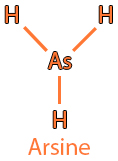Introduction
Arsine (AsH₃) is an extremely toxic gas that is generated upon exposure of arsenic-containing ores to acids. It is also a by-product of refining of non-ferrous metals. Arsine is used extensively in the manufacture of microchips, solid-state lasers and for the synthesis of organoarsenic compounds. Arsine (AsH₃) is a colourless, flammable, non-irritating toxic gas with a mild garlic odour.

Arsine (AsH₃) was investigated as a warfare agent during World War II because it is 2.5 times denser than air, as is required for a blanketing effect sought in chemical warfare, but it was never used on the battlefield.
How does activated carbon remove arsine (AH₃) from air?
The overall arsine (AsH₃) removal process from air using impregnated activated carbon type AddSorb™ VA4/Ag is as follows:
AsH₃ + O₂ → (As₂O₅, As₂O₃) + H₂O
Arsine removal with activated carbon is a stepwise process. The first step is the adsorption of arsine (AsH₃) into the micropores of the activated carbon:
AsH₃ (g) → AsH₃ (in the micropore, liquid)
Once the arsenic (AsH₃) is adsorbed it will oxidise in the presence of a carefully selected metal oxide (MO) impregnate, giving the stable arsenic trioxide:
2 AsH₃ + 3 O₂ → As₂O₃ + 3 H₂O
2 AsH₃ + 6 MO → As₂O₃ + 6 M + 3 H₂O
2 M + O₂ → 2 MO
Mobile and fixed filters
Jacobi Services offers a wide range of EcoFlow™ filters for removing arsine (AsH₃) from air. Please contact the Jacobi Services team for advice on the most suitable filter for your application.


